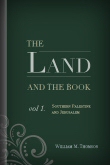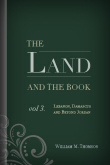The Land and the Book (3 vols.)
Digital Logos Edition
Overview
The Land and the Book is the result of over 40 years of missionary work in the Bible lands by William M. Thomson. To picture the scenes and scenery of the Holy Land, and to portray the manners and customs of the present inhabitants that illustrate the Bible, is the main object of the work. But to do that right, one must have seen and felt them; as this the author has done through many years of adventure, and whatever of life and truthfulness there may be in his illustrations is due to that fact. In these volumes, he takes the reader “through that ‘good land’ of mountain and vale and lake and river: to the shepherd’s tent, the peasant’s hut, the palace of kings, the hermit’s cave, the temple of the gods—to the haunts of the living and the sepulchers of the dead—to muse on what has been and converse with what is, and learn from all what they teach concerning the Oracles of God.” A large part of these pages was actually written in the open country. On seashores or sacred lakes, on hillsides or mountaintops, under the trees or the shadows of great rocks—there Thomson lived, thought, and wrote.
Rich with scriptural landmarks and filled with hundreds of beautiful pen-and-ink illustrations, Thomson’s The Land and the Book has been a popular classic for over 100 years. Learn more about the people, places, and historical events behind the text you’re studying. Incorporate pictures, illustrations, and graphics into sermons, school papers, or Sunday school lesson plans. Whether you are a student, pastor, scholar, or layperson, the 3-volume Land and the Book is a must-have resource for Bible study or reading.

- Descriptions of Palestine, Jerusalem, Phoenicia, Lebanon, Damascus, Jordan, and more
- Hundreds of beautiful pen-and-ink illustrations
- Exciting narration of Thomson’s missionary work and travels
- Title: The Land and the Book
- Author: William M. Thomson
- Publisher: Harper & Brothers
- Volumes: 3
- Pages: 1,992
Individual Titles

The land where the Word-Made-Flesh dwelt among men must ever continue to be an important part of Revelation, and Palestine may be fairly regarded as the divinely prepared tablet whereupon God’s messages to men have been graven in ever-living characters by the Great Publisher of Glad Tidings. It is from this land we have received that marvelous spiritual language through which we gain nearly all true religious knowledge. Here it was devised and first used, and here are found its best illustrations.
The sites and scenes described in The Land and the Book were visited many times during the author’s long residence in the country; the results, so far as they bear on biblical illustration, appear in the current narrative. The conversations were held in the open country, on horseback, by the wayside, or beneath the traveler’s tent, and the reader is at liberty to regard himself as a compagnon de voyage. Volume one covers the Kingdom of Judah, including within its territorial limits the whole of Southern Palestine and Jerusalem.

Central Palestine, comprising Samaria and Lower and Upper Galilee, was not only the largest but also the most beautiful and fertile portion of the land of Israel, and it is now preeminently distinguished for the number, variety, and importance of its historic sites and sacred scenes. There lived and labored most of the great prophets mentioned in the Old Testament, and there also dwelt the Savior of men during nearly the entire period of his life on Earth. Though he was born in Bethlehem, Nazareth was his home, and in Capernaum, “his own city,” on the shore of the Sea of Gennesaret, many of his mighty works were accomplished.
To the believer and student of the Bible, the entire country from Bethlehem to Dan, and from Dan to Hermon, the Mount of the Transfiguration, and from there to “the coasts of Tyre and Sidon,” is invested with unique and unparalleled interest. Thomson’s personal acquaintance with that region has been exceptionally intimate, and “through every part of it he has wandered with delight for forty years and more, and to describe it has been a labor of love.”

The previous volumes of this collection covered Southern Palestine, Jerusalem, Central Palestine, and Phoenicia—mainly devoted to the Promised Land west of the Jordan. The present volume—the third and last—relates to the Lebanon, Coelesyria, Anti-Lebanon, Damascus, Bashan, Gilead, and the regions “beyond Jordan eastward.” Though not originally included in the Land of Promise, those adjacent districts were closely connected with it. Some of them were the first that were occupied by the patriarchs of old, others were the first taken possession of by the Hebrew nation, and all of them were most intimately associated with the children of Israel in their social, civil, and religious institutions and in their secular history. In traversing those regions, therefore, we are still in the land of the Bible, and drawing our biblical illustrations from the manners and customs, the scenes and scenery of the Holy Land.
William M. Thomson (1806–1894) was educated at Miami University and Princeton Theological Seminary. He began missionary work in Beirut, Syria, in 1833, and a year later he and his wife relocated to Jerusalem. His wife died in childbirth during the Palestinian civil war of 1834, and Thomson returned to Beirut with his infant son to continue his work. In 1835 he opened a school, a church, and a seminary for boys. In 1843, the school was moved to the village of Abeih in Mount Lebanon for safety, and he resumed teaching, preaching, and making extended missionary tours in Syria and Palestine despite the dangers they entailed. He took a two-year respite in the United States and then returned to Beirut in 1859, where he remained for the next 17 years. His actual connection with the mission in Syria covered a period of 43 years and 5 months.
Reviews
11 ratings

Bechthold Family ❤️
2/11/2023

Raymond Sevilla
9/22/2015
Dave St. Hilaire
7/29/2015

John L. Jefferson
9/10/2014
AeliusCicero
6/19/2014
JohnB
11/6/2013
My father picked up an old copy from the library of a deceased minister after ministerial students had cherry picked. They missed a pearl. In some ways it is the nearest one can get to traveling the Holy Land in person in Christ's time. I had been wondering about OCRing my copy to convert it as a Personal Book to Logos.James Mills Jr.
10/29/2013

RICHARD A. RAY
10/23/2013

Bill Shewmaker
10/8/2013

Larry Proffitt (I
10/2/2013